Welcome to the second entry in my investigation of the sorcerous stylings of Magic’s wizards!
Previously, I suggested that the wizard archetype serves an important role in high fantasy aesthetics, like those of Magic, because it embodies what the supernatural is and what it means to practice it—whether it means authoritarianism, artistry, mysticism, mercantilism, clericalism, physicality, vocationalism, or utter alienness. But where the last article discussed the overarching designs of various wizards’ wardrobe—the traditionalist, the sorcerer couture, and the alien arcane—this article examines the minor objects that make a Wizard’s aesthetic: the accessories, utilities, and paraphernalia.
Catching Up
Before I advance my analysis, however, I want to touch some gems of wizard fashion that I didn’t have the chance to mention in my last entry.
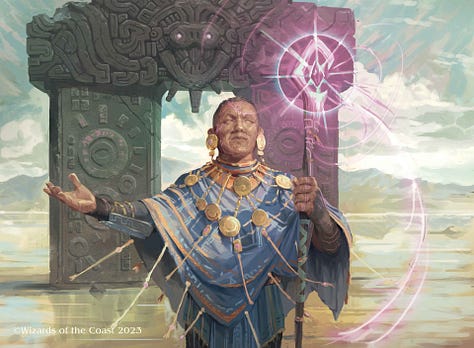
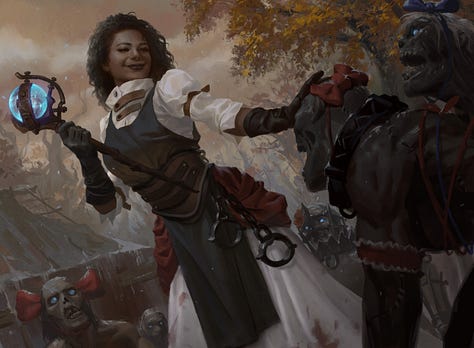

To begin with, I didn’t have time, though I wish I had, to mention the ways that Magic’s wizarding fashion expands the wizard archetype beyond the cultural signifiers of France and Britain. Aldo Domínguez’s “Sage of Days” uses fashion to instantiate the wizard archetype in Ixalan’s Mesoamerican-inspired Oltec culture, just as Billy Christian’s “Skaab Wrangler” does for the Germanic visual language of Innistrad, just as Matt Stewart’s “Burning-Fist Minotaur” does for Ancient-Egyptian-inspired Amonkhet—to name a few examples.


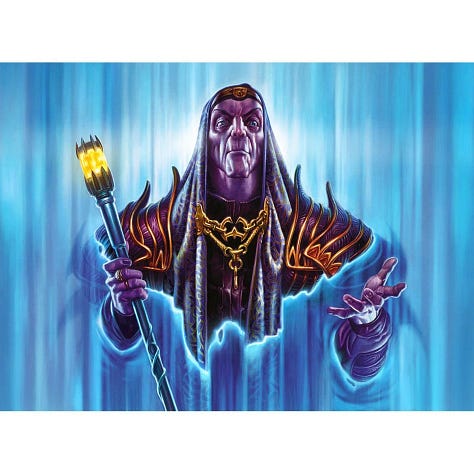
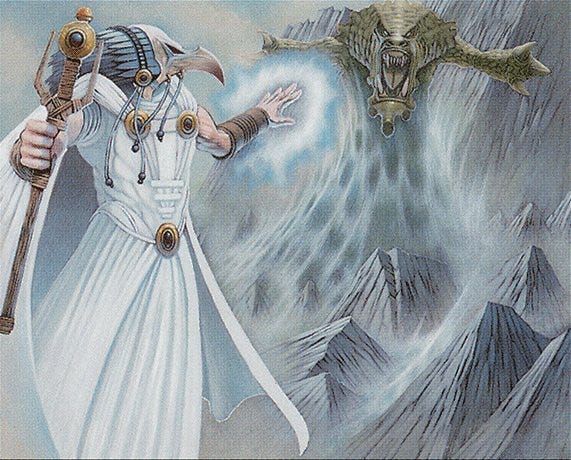
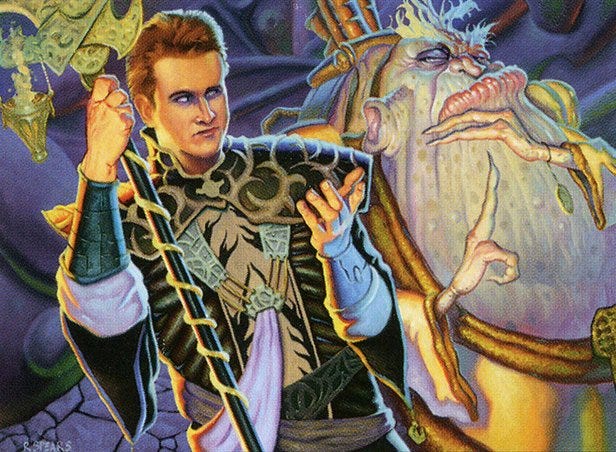
Nor did I have time, though I wish I had, to mention more cool tweaks on traditional wizard outfits, like the diamond-patterned robes of Kiernan Yanner’s “Drannith Magistrate,” the exquisite serpentine silhouette in Kaja Foglio’s “Coffin Queen,” the play of lobstered plate and cloth in Zoltan Boros and Gabor Szikzsai’s “Ith, High Arcanist,” the striking monochromatic alabaster and structured lineation of Wayne England’s “Disciple of Kangee,” and the interweaving arcane patterns in Ron Spears’ “Dark Confidant.”
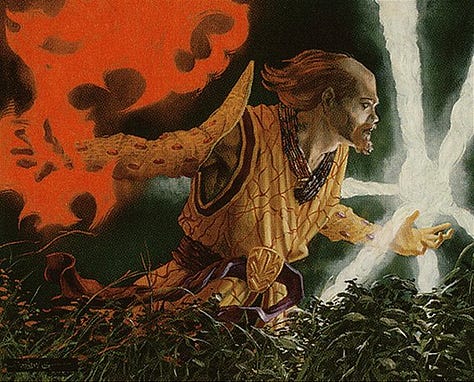

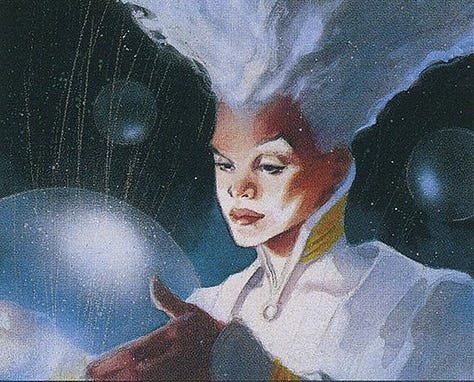
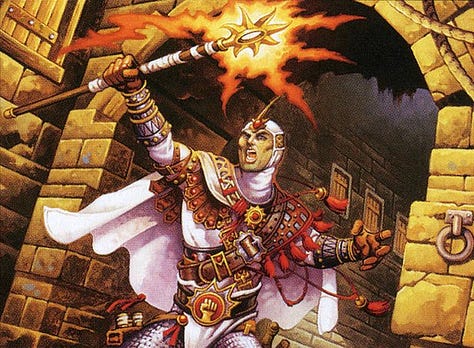
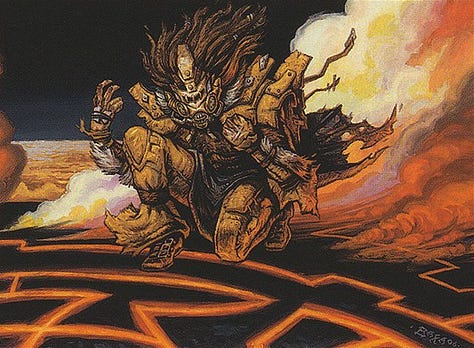


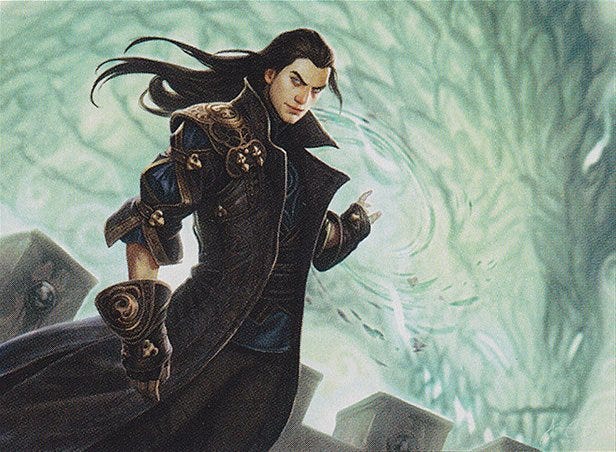
By the same token, I didn’t have time, though I wish I had, to mention sorcerer couture that pushed the boundaries of what wizarding is, from the loud color palette of Randy Gallegos’ “Thornscape Apprentice” to the muted tones of rk post’s “Bog Initiate,” from the sleek high collar and minimalist porcelain armor-robes of D. Alexander Gregory’s “Keeper of the Light” to the maximalist martial couture of Luca Zontini’s “Wojek Embermage,” from the post-apocalyptic grit of Thomas M. Baxa’s “Magus of the Arena” to the quasi-cyberpunk stylings of Greg Staples’ “Aphetto Grifter,” England’s “Crafty Pathmage,” and Jason Chan’s “Lord of the Unreal.”
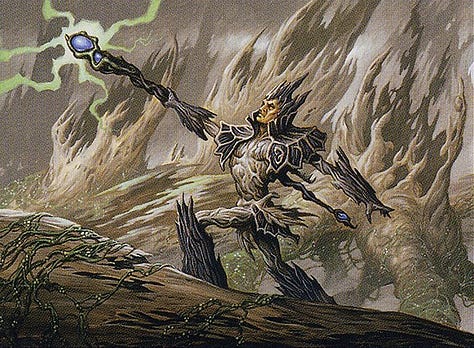
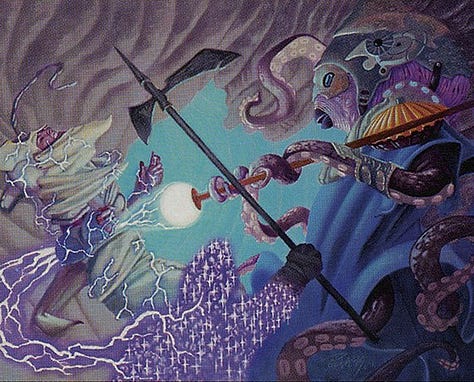


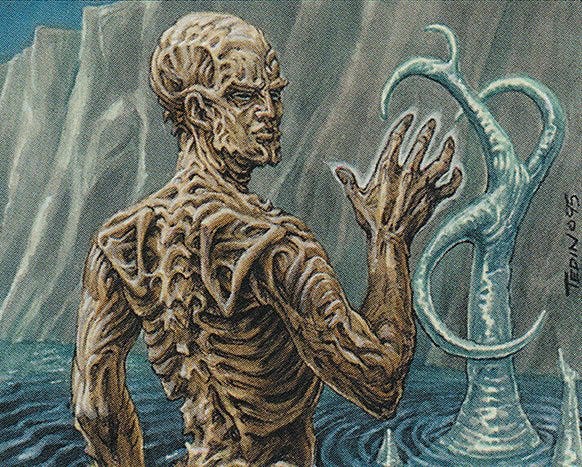
And certainly I didn’t have time, though I wish I had, to mention the alien arcane fashions that smack you in the face, imagining how magic exists beyond the boundaries of our visual vocabulary—as in the arboreal-sartorial trunk/body/clothing of Jim Nelson’s “Ana Battlemage,” the strange benthic/sci-fi look of Alan Pollack’s “Cephalid Constable,” the unsettling admixture of metal and flesh and fabric in Matt Stewart’s “Esper Stormblade,” the unknowable chthonic mystery of Nils Hamm’s “Death Baron,” and, perhaps my favorite of all, Mark Tedin’s buck-ass naked “Balduvian Conjurer.”
But, like I said, I don’t have the time to mention those. So let’s move on!
Staffing Solutions
In the visual language of Magic wizards are nothing without tools. In one way, this is obvious—but it’s also entirely surprising. A wizard possesses the ability to command the powers of nature with a flick of the arm, but they also need to use tools, to extend their body in space, to channel their power. They’re superhuman, but also still entirely human.
Perhaps the most interesting accessory, for its intrigue and its fashionability alike, is the staff. The origins of the staff’s association with wizarding are hard to pin down (perhaps it’s related to the staff with which Moses parts the Red Sea in Exodus? Perhaps it comes from the croziers carried by Christian clergy, which themselves may be related to the lituus of ancient Rome? Perhaps it’s derived from the simple commonality of seeing old men with walking sticks?), but in Magic, the common thread is that the staff transforms an everyday utilitarian instrument, the stick, into an extension of a wizard’s style—and thus their power.



Fitting the staff’s visual echo of Abrahamic clerics, some magical staffs blend ceremonial aesthetics with magical mystery. Volkan Baga’s “Academy Elite,” for example, represents a group of wizards whose filigreed robes and high hats echo something like European clergy; the leftmost figure’s tall, jewel-set staff certifies this image, whispering a quiet thrum of arcane power in the ecclesiastical halls. Slawomir Maniak’s “Augur of Bolas” is similarly ceremonial, but instead of echoing the solemn ornamentation of Christian art, he wields a curving staff whose head evokes a different, darker god: the megalomaniacal dragon Nicol-Bolas. Most recently, Wisnu Tan’s “Hashaton, Scarab’s First” wields an ornate gold staff set with glittering jade; the head’s wings evoke the ancient Egyptian god Maat and the leonine face of the Amonkheti god Oketra (though Hashaton’s flavor text suggests that he is the wizard-priest of a different god entirely). In any case, the molten light of his staff cuts a harsh contrast with the midnight blue of his lazotep body; the staff visually elevates him to a dignified station—or perhaps he is pulling the staff down to his own underworldly level.
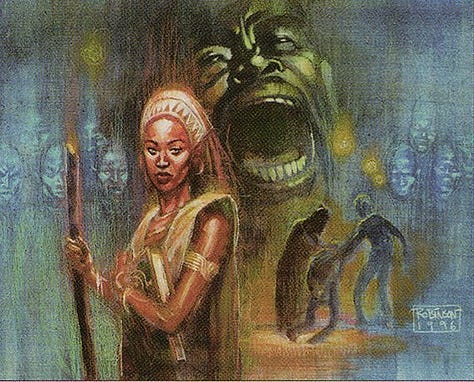

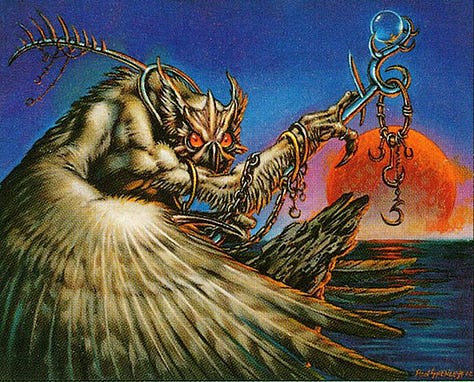
Beyond its visual-cultural implications, the staff is an important way of complementing or complicating the line of an outfit. A staff itself is, after all, linear in shape, and it can sometimes add necessary hardness or at other times add complicated coils to a fashion ensemble. An apt example is Andrew Robinson’s incredible “Civic Guildmage,” in which the soft curving arcs of the mage’s robes and headband are brought into relief by the simple curve of her staff. Christopher Rush’s “Apprentice Sorcerer” has the opposite effect: the titular sorcerer’s robes and armor are full of slices and slashes and etched curves, but his weird techno-staff comprises jagged lines that jerk in every direction, ending in a crescent-moon head larger than the mage’s own. This is not focus and balance, but rather bristling and almost offensive power. The staff in Ron Spencer’s “Crookclaw Elder” works by visual contrast, the sharp lines of the wizard’s feathers being brought into relief by the elaborate hooked curves of the staff—like if a keychain was also a demon.
Chris Rahn’s “Qasali Pridemage” and sits somewhere in the middle of hard lines and soft curves—which is fitting, given that his art and flavor text emphasize that he is between the Alaran shards of Bant and Naya. His clothing is a mix of Nayan tribal robes that blow with gentle curvature and Bantian armor that strikes hard, sharp lines, the staff combines both: sharp point and soft circle, a perfect blend between worlds.


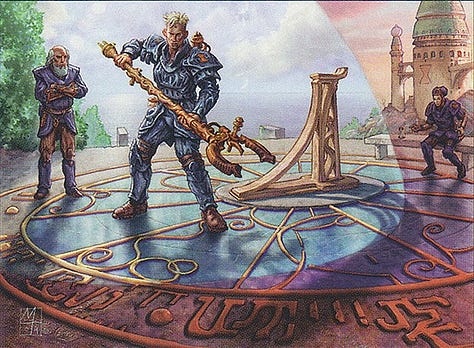
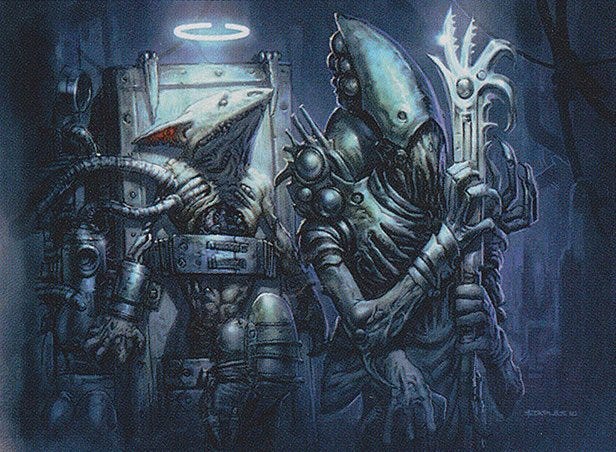
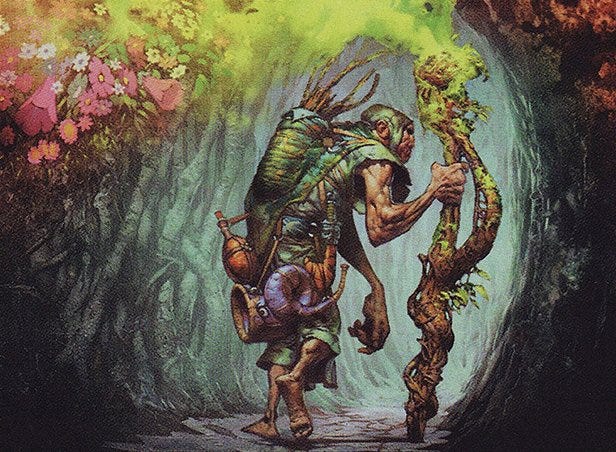
In other cases, a staff’s visual focal point is its material composition. Caio Monteiro’s “Aether Channeler,” whose outfit is one of my favorites in this entire series, wields a “staff” that appears partially constructed from blue electricity—a fitting complement for his work on unpredictable elemental forces. Dmitry Burmak’s “Vodalian Hexcatcher,” wields a staff made of intertwining driftwood or coral—this is magic by way of The Little Mermaid, while “Magus of the Vineyard”’s sparse clothing contrasts with the thick, gnarled wood of his staff, more tree than stick. On the other side of the spectrum, the highly ornamental metallic staff in Mark Tedin’s “Temporal Adept” appears like a natural extension of the subject’s complex metallic safety suit, while the shining steel of Greg Staples’ unsettling “Vedalken Anatomist” asks what it means for a sorcerer to be a surgeon—and not an ethical one, at that.
What emerges from all these cases is that the staff stands at the intersection of utilitarian tool and aesthetic appendage: it serves as the wizard’s equipment of choice, their answer to the ranger’s bow or the paladin’s blade, but it also gives a sense of how their body aesthetically extends in space, what it means and feels and looks like for them to engage with the world beyond their fingertips.
ABO: Always Be Orbin’
Beyond the staff is a different magical accessory, indeed one of the most versatile in all of Magic: the orb.
The orb, as our cultural vocabulary helps us imagine it, is a tool for foresight, the crystal ball in which one might see the future—though in the 58 Magic Wizards whose art represents orbs, their powers abound.
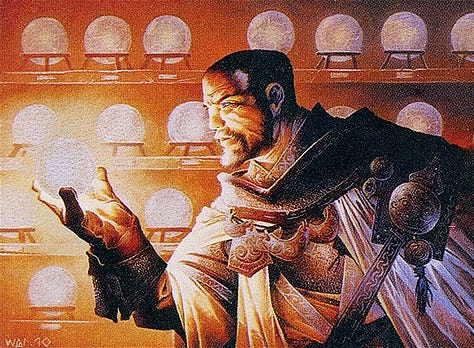
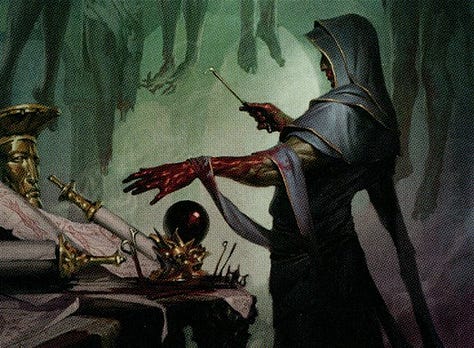

To be sure, some of the most memorable illustrated orbs do evoke preternatural vision—but they’re also chromatically mapped onto their users. Wayne Renolds’ “Auramancer” stares into a gleaming sphere of golden light, matching the light-neutral color palette of his robes; the obsidian ball that accessorizes Tyler Jacobson’s “Pain Seer” chimes with the deep, rich colors of the wizard’s dark robes and blood-spattered hands; Stephen Tappin’s “Thought Courier,” himself sporting the bulbous metallic head of a Mirran Neurok, stares into an orb the same crystalline blue as the goggle lenses shielding (or perhaps standing in for) his eyes.
Although it doesn’t technically come from a Wizard-typed card, Rebecca Guay’s “Dispersing Orb” is probably my favorite of all Magic’s orbs—not just because of the entirely unbothered expression of the subject, or because my friend/greatest cheerleader collects the card, but because the rippling steel-sky-blue of the orb represents a visual echo to the wizard’s lagoon-blue, peacock-embroidered robe. In each case, the most intriguing part about these orbs is not just what their users do with them, but also how wizards visually unfurl through them—are made, in other words, to appear visually resonant with their orbs and thus with the otherworldly power they command.


In other cases, orbs help visualize the specific character of a wizard’s power. Although orbs might not seem to be fashion in the sense that clothing is, a wizard’s mise-en-scene is undoubtedly part of the aesthetic picture they strike (literally). Michael Sutfin’s “Barrin, Master Wizard,” is surrounded by a constellation of gemlike orbs that at once evoke eyes, swirling planets, and glittering stars (in Ryan Pancoast’s homage, “Barrin, Tolarian Archmage,” the orbs become translucent sapphire models in a model of the solar system). The point, in any case, is not so much which thing Barrin commands as how his power feels: like the flaming arcing force, in Sutfin’s painting, that can bring disparate objects into alignment.
Elsewhere, the orb registers as contained energy itself. This is the case in Matt Cavotta’s “Etched Oracle” and Bram Sels’ “Teferi’s Protege,” in which blooming magical power crackles inside spherical containers, either contained by or drawn out by the sorcerous subject of each painting. But my favorite orb of power is Manuel Castañón’s “Stormcatch Mentor,” both because of the popping colors—deep indigo, electric blue, hazy gold, snowy gray, chocolate brown—and because it showcases how power can be accessorized. The otterfolk of Bloomburrow, represented here, play elaborate games with orbs that capture lightning, and here the central wizard’s staff is the anchor of that visual and electrodynamic exchange. Lightning flows from the orbs onto the ground, into the fluttering red-blue banner that matches the wizard’s robes, into the orb at the tip of his staff, and rockets out into the air—or perhaps it’s working in the reverse, lightning from the sky flowing through the staff and into the other orbs. Regardless, the orbs (both those on the ground and the one on the staff) help give a sense of how a wizard’s power might become intimate to their person, the way that the visual whimsy of their tools can partake of their raw supernatural dynamis.
Hermetic Headwear
Our final stop in this adventure through wizarding is an item that, as we saw last time, was there at the very beginnings of Magic’s wizard art: the hat.
Hats are especially interesting stylistic objects because they blend functionality—a hat shades your face from the sun, contains your hair, protects your face—with pure ornament. Although headwear is functional, it’s also disproportionately aestheticized.

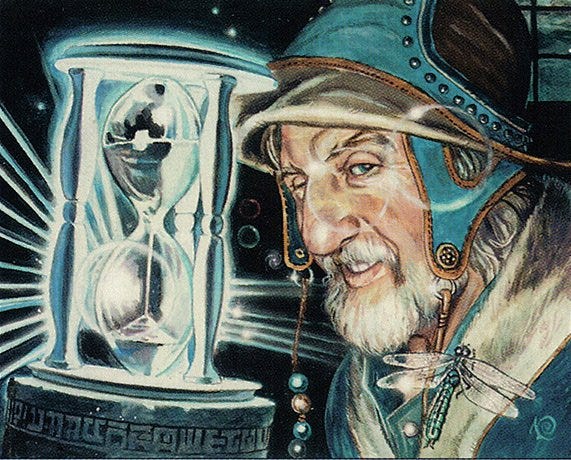
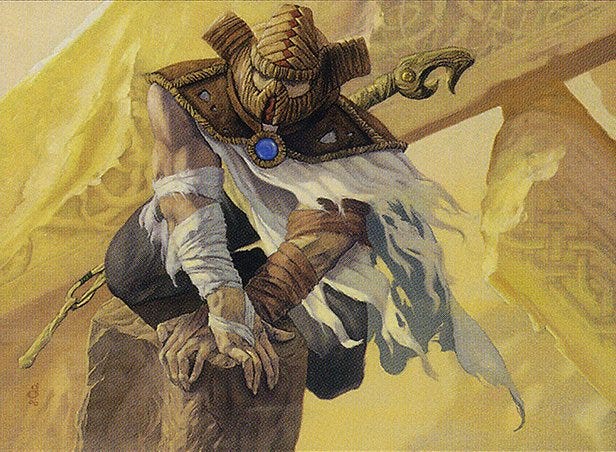
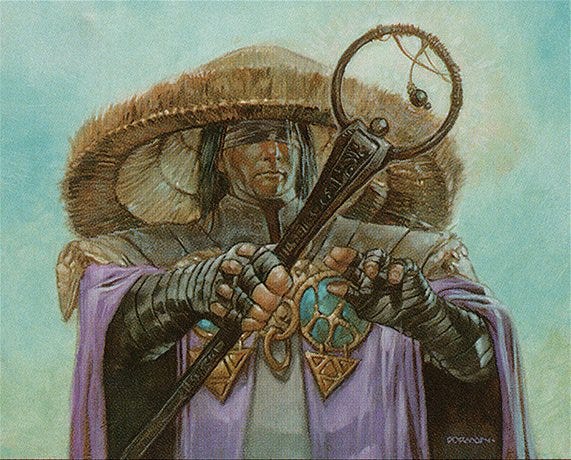
The game’s very first wizard, Douglas Shuler’s “Prodigal Sorcerer,” is behatted in a floppy pink cap, evoking the Renaissance quasi-clergy, quasi-aristocracy visual role that Wizards occupied in early Magic. Others are, or appear, more functional: Roger Raupp’s “Riptide Chronologist” wears a leather helmet, reflecting the character’s role as a researcher in the Otarian Riptide Project, while Randy Gallegos’ “Magus of the Tabernacle” wears a woven-wood helmet to shield his face from the blazing suns of post-apocalyptic Dominaria. Other hats simply seem silly, like that of Dave Dorman’s “Blind Seer”—though this absurdity itself matches the character, for the Seer is actually Urza in disguise, his veneer just barely falling away.
Other hats confer on their wearer an unsettling alienness, making them appear to have come from a reality foreign even to high fantasy. Matt Cavotta’s astonishing “Yixlid Jailer,” one of the most horrifying wizards in Magic’s ranks, strikes me as especially alarming in the way that the curved, insectoid helmet parallels the stretching, oil-black inhuman arms. The glowing ruby light on the helmet’s front throws light on the Jailer’s garish stretched smile, distending their inhuman horror into space.
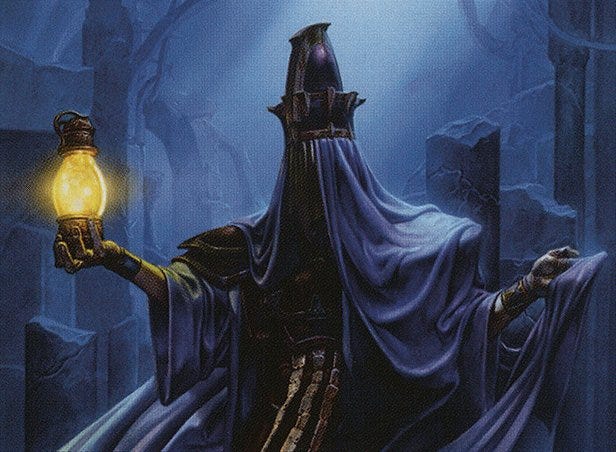
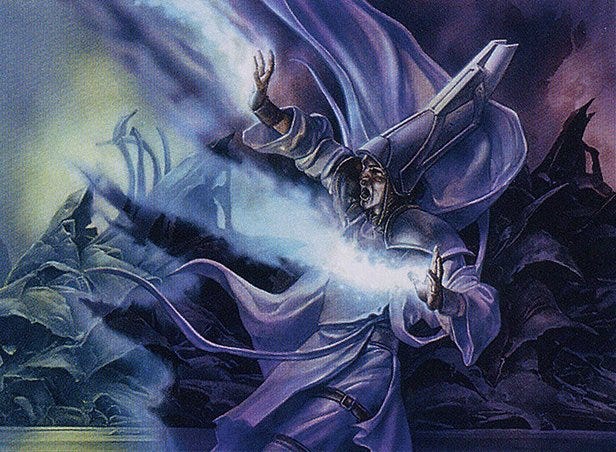
Some have a similar or even more intensely eerie effect, like that of Boros and Szikszai’s “Magus of the Jar.” This wizard’s hat, with its dark purple-and-gold color scheme and its unsettlingly geometric shape, if its subject even has a head to protect—whether it’s not a human using magic but something far darker, far more horrifying taking the human guise. Boros and Szikszai did further fun work with hats in “Timebender,” which is also oversized but far less menacing. The chronomancer’s headwear, nearly the length of his torso and double the length of his arms, appears to be a melded mixture of cloth and metal, befitting the quasi-science-fictional premise of his powers. The hat’s design implies that it has some kind of utilitarian function, but its aesthetic is so plainly ridiculous—and this tension, I think, has the productive effect of evoking the Timebender’s strange, deeply esoteric magic.

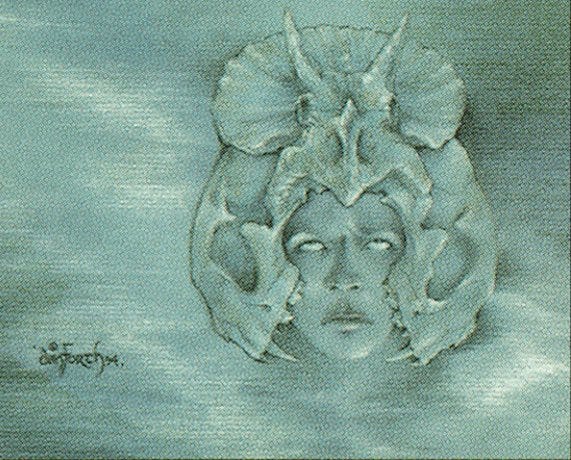
To be sure, plenty of hats are purely ornamental, like the highly decadent, highly impractical, highly cool-looking bladed headpiece on Karl Kopinski’s “Kheru Lich Lord.” This helmet jibes with the dim burnished gold of the lich’s equipment and confers on him a certain worldly regality, but its strange impracticality—how would you even put it on?—implies the kind of ancient mystery that’s confirmed in his zombified face. Other ornamental helmets channel a more primeval aesthetic, like those of Liz Danforth’s (hilarious) “Tuknir Deathlock.” Like most of the characters in Legends, Deathlock was likely based on a character in a Dungeons and Dragons game—which feels legible in his absurd-but-awesome helmet, which encases his head in a triceratops head that blends into a T. Rex’s jaws. We know nothing about Deathlock’s appearance beyond this image, and the flavor text doesn’t give us any good ideas—so here, condensed in his face, is the sense of a wizard who is nothing if not (perhaps nothing more than) cool.
Casting Off
As per usual, when I sat down to write this piece, I thought, hey, there can’t be that many different wizarding outfits to track! This’ll be a breeze! What happened, as you’ve seen, is a that breeze through dozens of wildly different wizardly looks occupied a great deal of attention—and still remains, somehow, entirely incomplete.
Regardless, I hope I’ve helped throw some light on all the heavy-lifting clothing takes on in Magic’s art. A wizard is the embodiment of a world’s magic—but only insofar as their robes and hat and staffs and orbs (oh, those orbs) are. As fashion encodes for us, a wizard is a priest, a warrior, an alien, a scholar, a mystic, a bundle of curves, a series of straight lines, a burst of color, an explosion of energy, a cluster of twisting curls, and a multitude of textures. And the next time another Wizard-type card is printed, it’ll be something more.

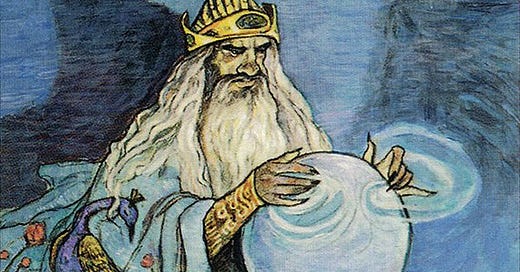






Oh yeah, that's the stuff! I've been looking forward to this article and you didn't disappoint. I'm so glad you mentioned Coffin Queen too, one of my absolute favorite pieces of art in Magic, even if only in passing.
As you said, despite writing two phenomenal articles about the subject you've only scratched the surface of what wizards attire themselves with in Magic. And then there's warlocks and shamans too!